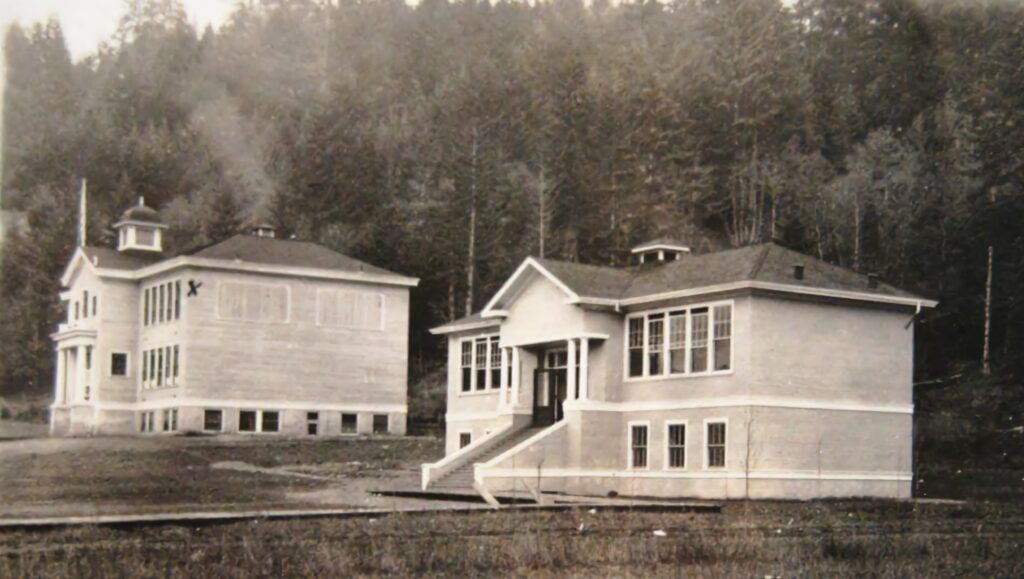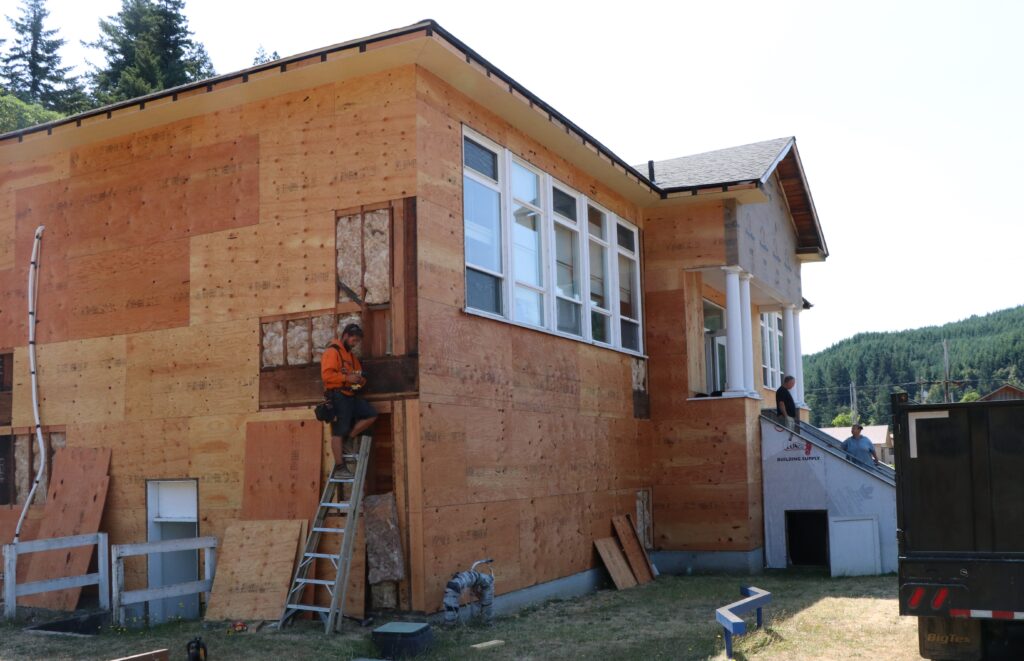
The Powers Elementary School (right) is being restored using an Oregon Seismic Rehabilitation Grant. It started as a two-classroom schoolhouse in 1917 but within a few years was tripled in size with four more classrooms added onto the back. The old high school (left) became a junior high in the 1950s and was torn down in the 1970s. (Photo courtesy of Patty Adamek)
Powers Elementary School sits just off a bend in Powers’ main road. The timber industry town in southwestern Oregon was founded in 1915, and the school building has been there since 1917.
The two-floor building, with its wide front steps and four pillars framing the doorway, is clearly visible to anyone passing through. Generations of locals say the school hasn’t changed much, from the hallway’s rich wood floors and the six spacious classrooms to the leaking lower floor with its small bathrooms.
The K-6 school was showing its age, though, and replacing it wasn’t really an option. An Oregon grant program presented a perfect opportunity to restore the school.
“There are things I would try to do, but tearing down this old building isn’t one of them — too much of a landmark,” said Superintendent Matt Shorb. He went to school in the old building and later taught there before becoming superintendent 18 years ago.
Instead, he turned to the Seismic Rehabilitation Grant Program. The Business Oregon program offers competitive grants to school districts, community colleges and education service districts to strengthen public buildings so they can survive earthquakes and provide a safe community space. This year it awarded $60 million to 24 education-related projects.
Powers’ first application failed, but on the second try it received almost $1.5 million, and work began this summer. Contractors tore off the siding and exposed some interior walls to add reinforcing beams and pillars. In early August, the exterior was mostly new plywood, with patches of old siding and insulation visible. Community members are pleased to see the work.

The Powers School District is strengthening the structure of its 1917 elementary school while preserving its character. (Photo by Jake Arnold, OSBA)
“It’s about time,” said Trisina Vinson, who lives across a street from the school. She said little changed in the school between her oldest son, now 27, and youngest son, 8. “I’m excited to see what it looks like.”
The grant will pay for replacing the siding and interior walls as well as a new roof and some electrical and plumbing upgrades. The district added $100,000 of its own money for contingencies and to do additional plumbing and electrical work made more convenient and less expensive by the rehabilitation.
Shorb said the building’s basic character will remain the same. The color will revert to its light gray from before a pale green siding was added decades ago. The new siding will look similar but be of better quality, he said. Antique doors and wainscoting will be preserved, but newer touches such as LED lighting will make the rooms more comfortable.
Glenda Fry, the budget committee vice chair, said the investment was an easy decision with no public opposition. She went to school there in the 1970s.
Community member Brian Mathiesen likes the idea of dropping his children off at a fresh-looking school. “It’s nice to see a small town staying alive,” he said.
Community member Anthony Alvarez said it makes him feel hopeful about his town’s future.
Shorb oversaw a similar rehabilitation grant job five years ago on the district’s “new” high school, which graduated its first class in 1957.
“Expect the unexpected,” he said. The high school job revealed things such as skylights in the classrooms that had been covered. In the elementary school, they learned the building had originally been only two rooms, but the community tripled the school’s size within a couple of years.
They also found more extensive damage from a fire in the 1940s than anyone realized. Decaying windowsills and extensive dry rot increased costs, but the district is working with its contractors to find other places to save money.
Shorb said he has had to learn a lot about contracting and construction, something not covered when he was studying for his administrator’s license.
“It falls under the umbrella of things they don’t think about teaching you in class,” he said.
School board member Merle Kalb, a retired contractor, said the board told Shorb: “Do what needs to be done, and we will find money in the budget.”
Shorb hopes to have the classrooms and bathrooms ready for use when school starts Sept. 5, but exterior work will likely stretch well beyond that.
Patty Adamek moved to the town in 1957 and started fifth grade in the elementary building. She remembers singing from behind the school’s front pillars, even though she wasn’t supposed to be up there. When she walks the halls, she feels like that little girl again.
Adamek, a former school board member who researches the town’s history, said the old school is the community’s heartbeat.
“It’s what holds us together,” she said.
– Jake Arnold, OSBA
[email protected]
To listen to residents’ memories of the school, go to the OSBA Sounding Boards podcast page.